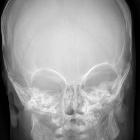Wiskott-Aldrich syndrome
Wiskott-Aldrich syndrome (WAS) is a rare immunodeficiency disease.
Epidemiology
The incidence currently quoted is approximately 4 per million live male births, although there can be regional variation. Rarely occurs in females.
Clinical presentation
It has a characteristic phenotype that includes:
- petechiae, bloody diarrhea, and epistaxis due to thrombocytopenia with small platelets
- eczema that starts in the first month of life
- recurrent infections with encapsulated bacteria due to immunodeficiency
- increased incidence of autoimmune manifestations and malignancies (e.g. primary CNS lymphoma)
Pathology
The pathophysiology relates to structural mutation with defective actin polymerization in hematopoietic cells as a result of deficient or dysregulated activity of the Wiskott-Aldrich syndrome protein (WASp) which has multiple functions. There is a poor antibody response to polysaccharide antigens. Low IgM, but high IgA and IgE levels.
Genetics
It is mostly an X-linked recessive condition.
Associations
Treatment and prognosis
The severity of the disease is variable and can be predictable from the genotype to a certain degree. Bone marrow transplantation may be the only definitive treatment .
History and etymology
It was originally described by Wiskott in 1937 as a triad of ear discharge, eczema and thrombocytopenia. The genetics, i.e. X-linked recessive disorder, were described by Aldrich in 1954.
Siehe auch:
und weiter:

 Assoziationen und Differentialdiagnosen zu Wiskott-Aldrich-Syndrom:
Assoziationen und Differentialdiagnosen zu Wiskott-Aldrich-Syndrom:

